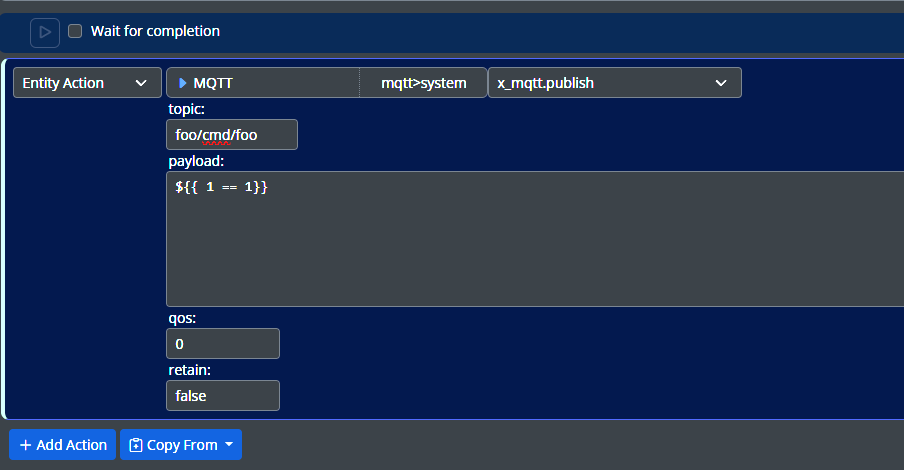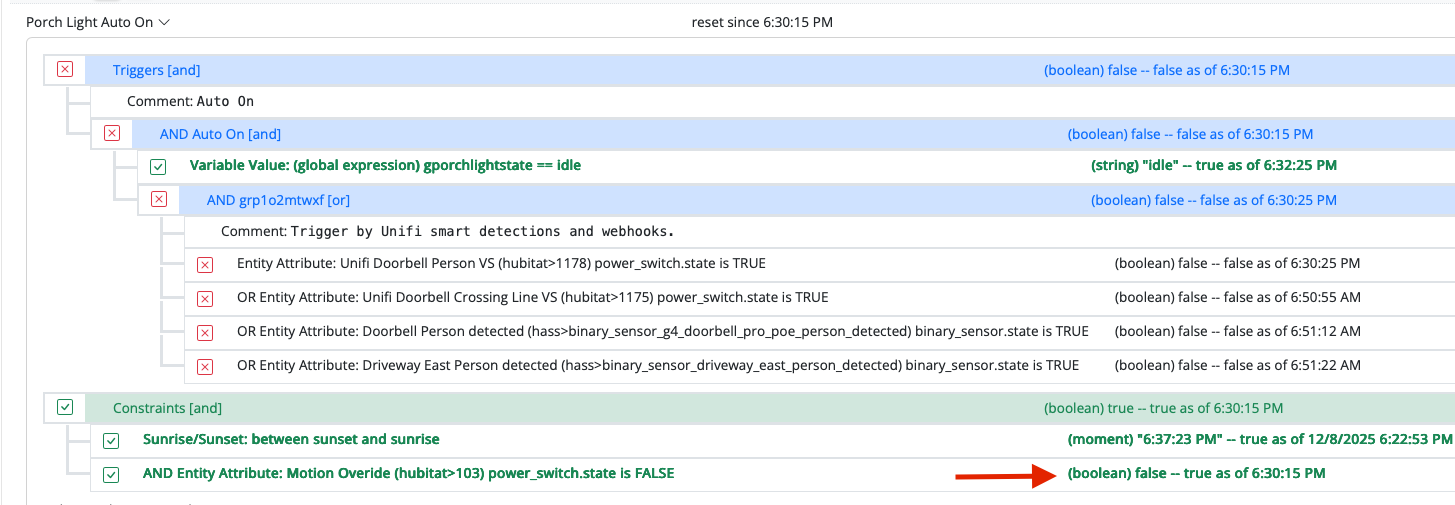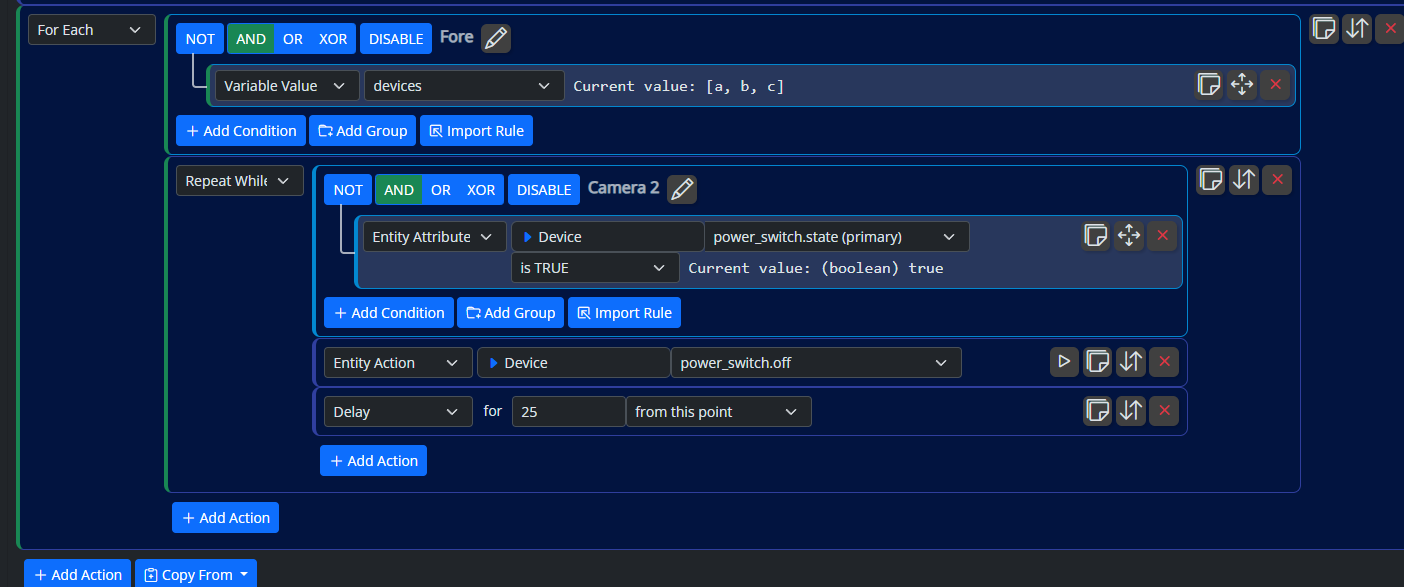Thanks for the replies. I assumed that I would have to go about it a different way that what I was doing on the Vera with Reactor.
d868
Posts
-
Using duration of a rule or trigger in an expression -
Using duration of a rule or trigger in an expressionHi, I have a rule that I have been using in the Vera version of Reactor for a number of years and I am trying to recreate it in MSR and need some advice. The rule monitors the state of our garage door and sends a regular alert if the door has been open for a period of time. The alert contains a variable/expression that provides the duration in minutes the door has been open - eg the end notification looks like this: "The door has been open for X minutes"
I have everything working OK in MSR except for constructing the expression to provide the duration the door has been open. In Reactor I was using the 'getstate' function in an expression to get the runtime of the rule and then converting that to minutes and passing it to the notify action.
In MSR I can't work out how to get any info from a rule within an expression.
The trigger is a simple pulse every X minutes so I was hoping it would be possible to just get the duration of either the rule or the time the door has been open. In the documentation there is a lot of info on getting details of entities, but I couldn't find anything on getting the status of the rules within MSR as it doesn't look like they show up as entities? I hope I didn't miss that part of the doco.
I did a bit of searching but couldn't find any discussion on getting this type of info so I'm hoping someone will be able to point me in the right direction.
I'm using build 22179 on Docker and the devices are currently in Vera but I am likely to move them to HASS at some point.
-
Restart Reactor option not working on QNAP dockerIf I get some time I'll test it for you and let you know via this thread, but I've made a point with this NAS of not doing anything in the command line because I want to keep it as out of the box and standard as possible. I know it's not hard, but my last NAS was basically all command line and a lot of tweaking which made for some interesting times during some upgrades so this time I'm keeping it all standard and working around any limitations.
For the documentation I wasn't suggesting you document specific issues with platforms, just what the button actually does which would help anyone in the future if they were wondering what was happening. It maybe just me, but I wouldn't have bothered to ask about this if I'd realised that the restart was an OS thing, not part of the button function. Eg: The restart reactor button shuts down reactor (or the container) and the OS is then responsible for automatically restarting MSR using whatever specific method is supported.
Anyway, coming from Reactor on Vera I'm very happy with MSR so far and this was just a suggestion.

-
Restart Reactor option not working on QNAP dockerAh, now that I know the button is just shutting down MSR and not trying to actually restart it that explains what's happening. I haven't had much luck with the auto start even though it's turned on so I just do a manual restart when needed. Thanks for suggesting some links, but don't worry about looking into it any further. I'm not worried about it, but it's good to have it documented here if anyone else comes across it in the future.
Might be handy to add something to the documentation about what the button actually does when you get to updating the Tools section.
-
Fibaro FGD212 and dimming (HomeAssistant)Thanks for the super quick resolution on this PR!
-
Restart Reactor option not working on QNAP dockerHi @toggledbits here is the thread to discuss the restart issue with MSR as discussed.
When I use the Tools > Restart Reactor button in the UI it shuts down reactor successfully but doesn't restart. It doesn't bother me as I can easily restart it manually via the docker UI, but thought it would be still worth posting it if anyone else has the same issue, or if you want to look into it.
I'm running MSR using the latest-generic-amd64 docker image on a QNAP NAS via the standard docker implementation (container station).
-
Fibaro FGD212 and dimming (HomeAssistant)Thanks. TIcket has been logged in Mantis.
-
Fibaro FGD212 and dimming (HomeAssistant)Hi @toggledbits, do you have any thoughts on this? I was going to have a look at the mapping myself to see if it's just additional capabilities that need to be updated, but I wanted to check with you first. I'm running MSR as a docker container so if that's what needs to be done are the devices and capabilities YAML files within the docker image, or the configuration volume? I see in the documentation you mention that we can create our own mappings and capabilities by creating configuration files in the local subdirectory of the Reactor installation. Is that within the config volume, or do they need to be within the container? If that's what's required I was hoping to have a look at the system config ones to check the formatting required.
-
Fibaro FGD212 and dimming (HomeAssistant)Hi, has anyone got a Fibaro FGD212 dimmer working with Home Assistant and MSR? I have moved one of these devices from my Vera controller to my Home assistant controller and MSR isn't displaying any of the dimming capability. When it was on the Vera it showed the dimming capability in MSR and all the associated actions, but now it's on the Home assistant controller I can't see those in MSR.
In Home assistant I can see and use the dimming OK, so I'm wondering does MSR just need to have the mapping/capability added to the HASS configuration, or is there something more that needs to be done?
-
MSR in Alpine Docker@parkerc thanks. I'm trying to avoid doing anything by command line if I can, but if you do end up creating a guide I'll see how I go with it. In the meantime I'll have a bit of a play around with Container station to see if I can get the syntax right for creating it myself via the GUI.
-
MSR in Alpine DockerI'm just starting to look at ways to migrate away from Vera and just started working on a Home Assistant setup so I'd also love to have a go at testing this out in Docker on a QNAP but I don't really want to have to SSH into the NAS to do the docker compose, etc. I have only ever used the docker hub to add docker images but it looks like it's possible to use the QNAP container station to create a docker image locally but the steps you posted a few days ago in the thread don't seem to be in the format that the GUI needs, or I'm doing something wrong. If there aren't any QNAP gurus around I'll wait for something to come up.







